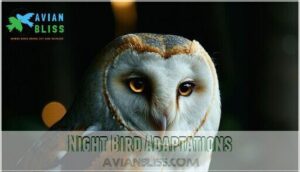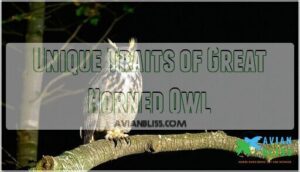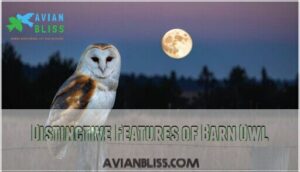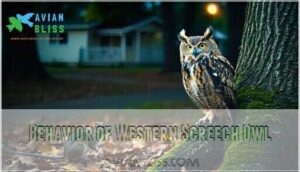This site is supported by our readers. We may earn a commission, at no cost to you, if you purchase through links.

Great Horned Owls dominate with their iconic hoots, while Barn Owls patrol farmlands with ghostly silence.
Western Screech Owls trill from backyard trees, and Burrowing Owls nest underground in grasslands.
The majestic Great Grey Owl haunts mountain forests with haunting calls.
These nocturnal hunters possess extraordinary adaptations—eyes that capture moonlight, feathers that muffle flight sounds, and hearing sharp enough to detect prey from incredible distances.
Each species has carved out unique niches across California’s diverse landscapes, from coastal areas to Sierra Nevada peaks, making them nature’s most efficient nighttime predators with fascinating survival strategies.
They thrive in various environments, utilizing their adaptations to become efficient nighttime predators.
Their ability to navigate and hunt in the dark is a testament to their remarkable biology and ecological importance.
Table Of Contents
- Key Takeaways
- Nocturnal Birds in California
- Characteristics of Nocturnal Birds
- Night Bird Adaptations
- Nocturnal Bird Identification
- Nocturnal Birds Beyond California
- Frequently Asked Questions (FAQs)
- What is the night bird in California?
- What birds are chirping at 3am in California?
- Why do birds chirp at night in California?
- What kind of bird is out at night?
- Are there non-owl nocturnal birds in California?
- What do nocturnal birds eat?
- How do they find their prey?
- How do you identify nocturnal birds?
- What sounds do California night birds make?
- When is the best time to hear them?
- Conclusion
Key Takeaways
- You’ll discover that night birds in California have extraordinary adaptations, like enlarged eyes and specialized feathers, that enable them to thrive in darkness and become efficient nighttime predators.
- As you explore California’s diverse landscapes, you’ll find over 15 species of nocturnal birds, including owls, nightjars, and mockingbirds, each with unique characteristics and habits that contribute to the state’s avifauna and ecosystem.
- You’ll learn that identifying nocturnal birds requires practice, and you can do this by listening to their unique calls, observing their plumage, and tracking their habits, making it easier to recognize them at night.
- By tuning in to the fascinating world of night birds in California, you’ll gain a deeper appreciation for these creatures that utilize darkness to their advantage, and you’ll be able to hear them at dawn, dusk, or midnight, when many night birds are most active and vocal.
Nocturnal Birds in California
California’s varied landscapes support over fifteen nocturnal bird species, from the powerful Great Horned Owl with its haunting yellow eyes to the ghostly Barn Owl that glides silently through the night.
You’ll find these remarkable hunters active after sunset across diverse habitats, including coastal regions, mountain ranges, deserts, and even urban neighborhoods where they’ve adapted to city life, becoming a part of the urban neighborhoods and diverse habitats.
Great Horned Owl
You’ll recognize the Great Horned Owl by its deep "hoo-h’HOO-hoo-hoo" call echoing through California’s darkness.
These powerful raptors dominate the night with exceptional hunting skills and intimidating presence. Their silent flight and crushing talon strength make them apex predators among California owls.
Many enthusiasts enjoy browsing owl-themed merchandise.
- Wingspan reaches 4.5 feet – massive for stealth hunting
- Talons crush with 500 pounds pressure – deadly hunting advantage
- Piercing yellow eyes – perfect night vision adaptation
Barn Owl
California’s night birds include the distinctive Barn Owl, easily spotted by its heart-shaped white face and ghostly appearance.
These California owls prefer open farmland and residential areas where their unique vocalizations—harsh screeches rather than hoots—echo through darkness.
Their barn owl diet consists mainly of rodents, making them valuable pest controllers.
To further deter pests, some people consider using a realistic owl deterrent.
Despite habitat loss pressures, their adaptable nesting habits in barns, abandoned buildings, and tree cavities help maintain stable populations across the state.
Western Screech Owl
While Barn Owls haunt open fields, Western Screech Owls master California’s wooded neighborhoods.
These nocturnal birds CA residents often hear but rarely see excel at Urban Adaptation, thriving in parks and residential areas. Their Vocalizations create distinctive trilling sounds you’ll mistake for insects chirping.
Don’t let their compact size fool you—these owl species California hosts are fierce predators. You can even find Western Screech Owl gifts online.
- Diet Specifics: Tackle rodents twice their body weight with surprising strength
- Nesting Habits: Prefer tree cavities in wooded urban environments
- Conservation Status: Stable populations thanks to remarkable adaptability
Burrowing Owl
Unlike their tree-dwelling cousins, Burrowing Owls break all the rules by living underground.
These quirky California night birds make their homes in abandoned ground squirrel burrows across open grasslands and agricultural areas.
Active both day and night, they hunt insects and small mammals while facing serious conservation challenges.
Their range is documented in California’s wildlife data, which supports conservation efforts.
| Aspect | Details |
|---|---|
| Habitat | Open grasslands, agricultural fields, desert regions |
| Diet | Insects, small rodents, ground-dwelling prey |
| Threats | Habitat loss, human development, ground disturbance |
| Behavior | Ground-level hunting, burrow nesting, diurnal activity |
| Status | Species of Special Concern in California |
Great Grey Owl
These silent predators showcase stunning grey plumage and piercing yellow eyes, earning endangered status in California.
Unlike Great Horned Owls or Barn Owls, they practice nest usurpation, commandeering old raptor homes rather than building their own.
Their stealth hunting techniques make them formidable nocturnal hunters.
Habitat protection remains essential for their survival, distinguishing them from more common Longeared, Barred, or Burrowing Owls throughout the state.
Characteristics of Nocturnal Birds
Night birds possess remarkable adaptations that allow them to thrive in California’s darkness, including enlarged eyes that capture minimal light, specialized feathers that create silent flight patterns, and enhanced hearing abilities that help them locate prey and avoid predators.
You’ll notice these birds have developed unique behaviors like daytime roosting in concealed locations and coordinated nighttime migration patterns that maximize their survival in nocturnal environments.
Large Eyes for Enhanced Night Vision
Most nocturnal birds CA possess dramatically oversized eyes that function like natural night-vision goggles.
Their eye size creates exceptional light sensitivity, gathering available moonlight and starlight for nocturnal hunting.
Enhanced binocular vision provides precise depth perception, while specialized retinal structure amplifies dim illumination.
When identifying night birds, notice how their eyes appear disproportionately large compared to daytime species – this California wildlife nocturnal adaptation enables effective nocturnal bird behavior in darkness.
Silent Flight for Predation Avoidance
California’s night birds have perfected the art of stealth through silent flight, giving them an evolutionary advantage for hunting success and predator evasion.
Their specialized wing shape and feather serrations break up air turbulence, allowing these nocturnal birds to approach prey undetected.
Here’s how these night predators achieve their ghostly flight:
- Feather serrations on wing edges reduce air friction and noise
- Velvety down feathers muffle sound vibrations during flight
- Flexible feather fringes eliminate the whooshing sounds other birds make
- Large wingspan relative to body weight enables effortless, silent gliding
Roosting Behavior During The Day
When darkness fades, California’s night birds find secure roosting locations to rest until evening returns.
You’ll discover these nocturnal species tucked away in tree cavities, dense foliage, or abandoned structures where their camouflage techniques keep them hidden from daytime predators and curious observers.
Like their Florida counterparts, some species exhibit unique visual adaptations for traversing the night.
| Roosting Behavior | Description |
|---|---|
| Roosting Locations | Tree cavities, dense shrubs, abandoned buildings provide shelter |
| Camouflage Techniques | Mottled feathers blend with bark patterns and shadows |
| Social Roosting | Some species gather in small groups for warmth and protection |
| Predator Avoidance | Strategic positioning near escape routes and cover |
| Energy Conservation | Reduced activity during daylight hours preserves hunting energy |
Migratory Patterns at Night
Billions of night birds cross California skies during migration seasons, transforming darkness into highways of wings.
These California birds use nocturnal navigation techniques, relying on stars and magnetic fields for guidance.
Migration triggers include temperature changes and food availability, while stopover ecology determines rest locations.
Artificial light at night can disrupt bird behavior, causing disorientation and attraction to light sources.
- Witnessing thousands of birds silently streaming overhead fills you with wonder
- Light pollution disrupts ancient migratory patterns, leaving birds dangerously disoriented
- Climate impacts are shifting traditional routes, forcing adaptations
- Bird migration represents nature’s most incredible endurance feat
Night Bird Adaptations
You’ll discover that California’s night birds have evolved remarkable physical features that make them perfectly suited for darkness, including enlarged eyes that capture minimal light and specialized feather structures that muffle sound during flight.
These adaptations, combined with enhanced hearing abilities and sensitive facial discs, allow nocturnal species to hunt effectively while remaining nearly invisible to both prey and predators in complete darkness, utilizing their unique features to thrive in complete darkness.
Keen Eyesight for Prey Spotting
Sharp vision transforms California birds into nighttime predators.
Night vision turns ordinary birds into silent, deadly hunters of the dark.
You’ll find these nocturnal species have developed remarkable binocular vision that’s three times more sensitive than human sight.
Their enlarged eyes capture even faint moonlight, while specialized retinal structure packed with rod cells enhances light sensitivity dramatically.
Great Horned Owls can spot mice from 100 feet away in near-total darkness.
Barn Owls rely on their keen eyesight combined with exceptional hearing for precise prey detection.
These nocturnal adaptations allow night birds to hunt successfully when most creatures sleep, giving them a competitive advantage in California’s diverse ecosystems.
Their ability to thrive in the dark is a result of these unique nocturnal adaptations, and it plays a crucial role in their survival.
This unique combination of traits makes them well-suited to their environment, and allows them to occupy a distinct niche in the ecosystem.
Special Feathers for Camouflage
Beyond sharp eyesight, California’s night birds rely on specialized camouflage feathers for survival.
These nocturnal birds possess remarkable adaptations that make bird identification challenging even for experienced observers.
Feather characteristics that create perfect nighttime disguise:
- Feather Pigmentation – Muted browns and grays blend seamlessly with tree bark and shadows
- Texture Variation – Soft, fluffy Contour Feathers break up body outlines against backgrounds
- Disruptive Patterns – Intricate markings confuse predators and prey alike
- Feather Density – Layered plumage creates depth, enhancing concealment effectiveness
Whiskers or Sensory Organs for Detecting Prey
California’s night birds have developed remarkable sensory adaptations beyond their famous silent flight and camouflage.
These nocturnal hunters possess specialized whisker-like structures called rictal bristles that function as tactile sensors for prey detection in complete darkness.
Here’s how these sensory organs work:
- Whisker Sensitivity helps nightjars detect air vibrations from flying insects, acting like nature’s motion detectors around their beaks.
- Prey Detection occurs through specialized receptors that sense minute environmental changes, allowing precise tracking without visual confirmation.
- Sensory Organ Evolution has equipped nocturnal birds with enhanced bird hearing and tactile sensing capabilities that complement their night vision.
- Nocturnal Hunting relies on whisker morphology variations across species, with each bird’s sensory perception perfectly adapted to their preferred prey and hunting environment.
These adaptations work together to enable the night birds to effectively hunt and survive in their environments.
Nocturnal Bird Identification
You’ll need to observe specific physical features, behaviors, and calls to identify California’s nocturnal birds accurately in the darkness.
Each species displays unique characteristics, from the Great Horned Owl’s distinctive ear tufts and powerful yellow eyes to the Barn Owl’s heart-shaped white face and raspy screech call.
Unique Traits of Great Horned Owl
Spotting this magnificent apex predator becomes easier when you know what to look for.
The Great Horned Owl’s distinctive ear tufts aren’t actually ears—they’re feathers that help with camouflage.
These California birds possess haunting eyes and powerful talons that crush prey with incredible force.
| Physical Feature | Description |
|---|---|
| Ear Tufts | Horn-like feather clusters for camouflage |
| Eyes | Large, piercing yellow orbs for night vision |
| Talons | Razor-sharp claws with 300+ PSI grip strength |
| Flight | Completely silent wing beats for stealth hunting |
Distinctive Features of Barn Owl
You’ll instantly recognize a Barn Owl by its distinctive heart-shaped face and ghostly plumage that seems to glow in moonlight.
These California birds excel at identifying owls through their silent flight – you won’t hear them coming.
Their screech call sounds like a rusty gate, quite different from typical hoots.
Hunting adaptations include exceptional hearing that pinpoints prey in complete darkness, making them masters of nocturnal birds identification.
Behavior of Western Screech Owl
While barn owls glide silently through open fields, Western Screech Owls bring a completely different energy to California’s night scene.
These fierce little hunters pack serious attitude into their compact frames, taking on prey twice their size without hesitation.
You’ll recognize their vocalizations first – a distinctive bouncing-ball trill that echoes through wooded neighborhoods.
Their social behavior revolves around territory, with mated pairs defending their turf year-round.
Urban adaptation comes naturally to these nocturnal birds, thriving in city parks and suburban areas.
Hunting strategies include:
- Perch-and-pounce tactics from low branches
- Silent swooping on unsuspecting rodents
- Opportunistic feeding on insects and small birds
Nesting habits in tree cavities near human activity
Habitat Preferences of Burrowing Owl
Unlike most California night birds that nest in trees, burrowing owls make their homes underground in open grasslands and agricultural areas.
These adaptable hunters have developed unique habitat preferences that help them thrive in the Golden State’s diverse landscapes.
Here are three key habitat requirements for burrowing owls:
- Burrow Availability – They depend on existing ground squirrel burrows or similar underground spaces for nesting and shelter
- Grassland Management – Short vegetation in prairies and farmlands provides clear sightlines for hunting small mammals and insects
- Urban Adaptation – They’ve successfully colonized golf courses, airports, and suburban areas with suitable open spaces
Their diet influence and predator avoidance strategies work best in these carefully selected California bird habitats. To bolster their numbers, artificial burrows are often constructed.
Nocturnal Birds Beyond California
If you travel outside California’s borders, you’ll encounter an even broader range of nocturnal bird species that call different regions home.
From the Chuck-will’s-widow in Texas forests to the Whip-poor-will across eastern North America, these night birds showcase remarkable adaptations that help them thrive in darkness across diverse habitats.
Texas Nocturnal Birds
Beyond California’s borders, Texas hosts an impressive collection of nocturnal birds that’ll surprise any night bird enthusiast.
The state’s diverse landscapes support over fifteen species of Texas Owls, from the powerful Great Horned Owl to the diminutive Western Screech Owl.
You’ll find Barn Owls gliding silently through lowlands and residential areas, their ghostly white faces unmistakable in moonlight.
Nighthawk Migration brings seasonal visitors like Common Nighthawks, whose distinctive wing patterns create striking silhouettes against twilight skies.
Poorwill Habitats in Texas’s arid regions shelter these elusive bat-eared birds, perfectly adapted for catching insects mid-flight.
Their oversized mouths and sensitive whiskers make them efficient nocturnal hunters.
Conservation efforts across Texas focus on protecting wetland habitats where Barred Owls thrive.
Spotting these birds can be easier by learning about their distinctive nocturnal calls.
When identifying birds active at night, listen for the Screech Owl’s trembling call or the Great Horned Owl’s deep hoots echoing through swampy areas – sounds as distinctive as any California bird sounds night enthusiasts know well.
Nocturnal Birds in Other Regions
Nocturnal birds span diverse regions worldwide, showcasing remarkable global distribution across varied ecosystems.
Habitat variation ranges from oceanic environments where ashy storm-petrels hunt plankton to New Zealand’s forests housing flightless kakapos.
These night birds demonstrate unique adaptations like frogmouths’ camouflage plumage for perfect disguise.
Regional threats impact their conservation status, making night birds identification essential for protection efforts.
You’ll discover these birds active at night have evolved specialized survival strategies beyond California’s boundaries.
Nocturnal Bird Behavior and Adaptations
These feathered night shift workers have mastered the art of darkness through remarkable Sensory Adaptations. You’ll discover their Nighttime Communication involves complex calls that carry across miles, helping them establish territories and find mates. Their Sleep Patterns flip our world upside down—they’re most alert when you’re winding down for bed.
Urban Adaptation has allowed many species to thrive in city environments, making night bird watching more accessible than ever.
Their Foraging Strategies include:
- Silent flight with specialized feathers that muffle wing beats
- Enhanced hearing to detect prey movement in complete darkness
- Asymmetrical ear placement for precise sound triangulation
- Flexible neck rotation up to 270 degrees for panoramic awareness
Understanding California bird calls and night birds habitat preferences helps with night birds identification during your nocturnal adventures.
Frequently Asked Questions (FAQs)
What is the night bird in California?
You’ll find various night birds in California, including owls, nightjars, and mockingbirds, each with unique characteristics and habits, contributing to the state’s diverse avifauna and ecosystem.
What birds are chirping at 3am in California?
You might hear Northern Mockingbirds or Yellow-breasted Chats chirping at 3am, as they’re known to sing at night, especially during mating season, to mark territory and attract mates.
Why do birds chirp at night in California?
You’ll notice birds chirp at night in California to mark territory, attract mates, and defend against predators, with nighttime singing being a key behavior for young males during mating season.
What kind of bird is out at night?
Curiosity kills the cat," but you’re wondering what bird is out at night, and it’s likely an owl, given their nocturnal habits and distinctive hooting sounds, right?
Are there non-owl nocturnal birds in California?
You’ll discover non-owl nocturnal birds, like nightjars, nighthawks, and whip-poor-wills, exhibiting unique adaptations for nighttime activities in California’s diverse landscapes.
What do nocturnal birds eat?
You’ll find that nocturnal birds eat insects, seeds, fruits, and small mammals, depending on the species, with some, like nightjars, hunting insects around streetlights.
How do they find their prey?
You locate prey using exceptional hearing, vision, and silent flight, often hunting near streetlights that attract insects, allowing you to thrive in various California habitats.
How do you identify nocturnal birds?
Practice makes perfect" applies here; you identify nocturnal birds by listening to their unique calls, observing plumage, and tracking habits, making it easier to recognize them at night.
What sounds do California night birds make?
You’ll hear various sounds, including hooting, chirping, and screeching, as California night birds like owls, nightjars, and mockingbirds vocalize to communicate and attract mates.
When is the best time to hear them?
You’ll likely hear them at dawn, dusk, or midnight, when many night birds are most active, singing, or chirping to mark territory or attract mates.
Conclusion
Fast forward to your next nighttime adventure, you’ll be tuning in to the fascinating world of night birds in California.
These creatures thrive under the cover of darkness, utilizing extraordinary adaptations to become efficient nighttime predators.
Making night birds in California a unique group to explore.










